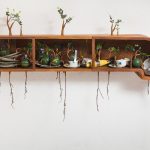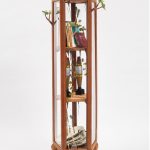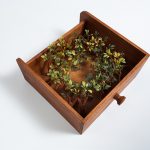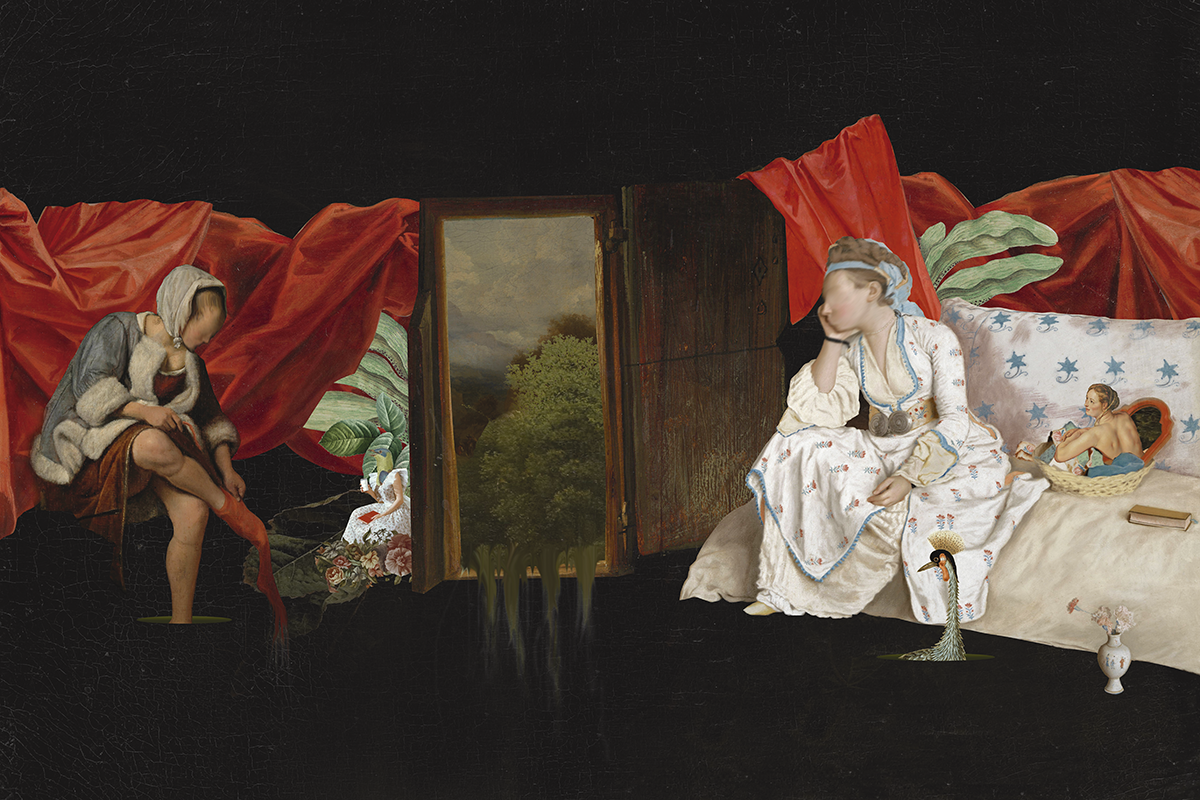-
-
Tour 3D
Click the link below to experience a 3D tour of the exhibition.
Clique no link abaixo para fazer um Tour 3D da exposição.
Camille Kachani – Imagined Identities (Tour 3D) -
Sobre a exposição/About the exhibition
Identity as a Refusal
Identity is an ambiguous word that can refer to an idea of belonging as well as to the radicalization of its expressions. Throughout the 20th century, many authors debated its meanings, indicating something subjective, constructed, that it carries. Stuart Hall was one of them. In The Question of Cultural Identity (1996), the author discusses identity as a process in constant update. “There is always something “imaginary” or fantasized about its unit. But it always remains incomplete, always in “process”, always “being formed”, says hall.
In effect, the view of identity as an experience in constant motion is precious to many of those who have their lives built in the midst of their movement among different cultures and continents. Among references, memories and affections that do not fit into only one language, the works of Camille Kachani seem to emerge from situations of this nature. Born in Lebanon to Syrian refugee parents who immigrated to Brazil in the 1970s, Kachani has his life affected by the three major monotheistic religions of the contemporary world: Islam, Judaism and Christianity. The artist´s closeness to beliefs generated from the same matrix – that are often opposed to one another – is translated into the refusal of adherence to any one of them, making it possible to estate them as reminiscences in constant update. Paradoxically, it is this refusal itself that makes the artist tackle, albeit involuntarily, the notion of belonging in his works.
Roots that spread vertically and horizontally (not always in search for the soil) adhere to the writing – an indispensable element in many of his compositions. In an allusion to the organic matter that will never be motionless, they indicate the inevitable passage of time, contrary to everything that aims to shorten it or to freeze it. This vital and often imperceptible continuity refers to the way Kachani understands his own artistic practice. “It is in principle about a never-ending work-in-process”, he says.
Carriers of history, each one of the images evoked by the works presented in this exhibition invites us to navigate through a biography. ”They are elements from the inside and the outside”, explains Kachani, pointing to the porcelains and grenades in one of his cabinets.
But what would this “inside and outside” be?
They are remains of Lebanon, which was about to enter one of the longest civil wars in history(1975-1990), reminding us that, as well as a teacup, weapons and debris were also part of the routine of its inhabitants. Intimate references to hard times, these objects can be seen as elements of compositions that refer to the political dimension inherent not only to public spaces but also to domestic spaces in society.
As with the moviemaker Ziad Doueiri in his movie West Beirut (1998), the artist suggests that ideologies, alliances and competition don´t fully explain the daily lives of countries in conflict. Despite the war, they still love one another, celebrate and then carry on with the most humdrum activities in life.
Part of some recent research, the photography series displayed here is also set in this context. Twigs, leaves and veins evoke situations that represent the conflict of nature with the human condition. The forest, as well as a tree, provides the model of circular capillary that takes place in an individual´s life: roots that lead to twigs and fruits that will consequently grow their own roots. Once again, the (un)taking root and its never-ending symbology provide the key to the expansion of the meanings of Kachani´s works.
In the midst of dualities that neither exclude nor oppose one another, the artist puts us face-to-face with a series of unlikely connections. Maybe this is a way to remind us that our own narrative also carries filial identity to which we relate, but we didn´t even know how to refuse. – Sabrina Moura
Identidade como Recusa
“Identidade é uma palavra ambígua que pode remeter tanto à ideia de pertencimento quanto à radicalização das suas expressões. Ao longo do século XX, muitos foram os autores que debateram seus sentidos, apontando para aquilo que ela carrega de subjetivo, de construído. Stuart Hall era um deles. Em The Question of Cultural Identity (1996), o autor discute a identidade como um processo em constante atualização. “Sempre há algo de ‘imaginário’ ou fantasiado sobre a sua unidade. Mas ela sempre permanece incompleta, sempre em ‘processo’, sempre ‘sendo formada’, afirma Hall.
Com efeito, a visão de identidade como uma experiência em constante movimento [e cara a muitos daqueles que têm suas vidas constituídas em meio ao trânsito por diferentes culturas e continentes. Entre referências, memórias e afetos que não cabem em um único idioma, a obra de Camille Kachani parece emergir de situações da natureza. Nascido no Líbano de pais sírios refugiados que migraram para o Brasil na década de 1970, Kachani tem sua vida atravessada pelos três grandes monoteísmos do mundo contemporâneo: islâmico, judaico e cristão. A proximidade do artista a crenças gestadas a partir de uma mesma matriz – que muitas vezes se opõem – se traduz na recusa de adesão a cada uma delas, permitindo-o citá-las como reminiscências em constante atualização. Paradoxalmente, é essa mesma recusa que leva o artista a abordar, ainda que de maneira involuntária, a noção de pertencimento em seus trabalhos.
À escrita – elemento primordial em muitas de suas composições – aderem raízes que se espraiam vertical e horizontalmente (nem sempre em busca de solo). Numa alusão à matéria orgânica que jamais será imóvel, elas apontam para a inevitável passagem do tempo, contrário a tudo que busca retraí-lo ou fixa-lo. Essa continuidade vital e muitas vezes imperceptível remete à forma como Kachani entende a sua própria prática artística. “Trata-se, antes, de uma obra em processo infindável”, afirma.
Portadoras de histórias, cada uma das imagens evocadas pelas obras apresentadas nessa exposição nos convida a navegar por uma biografia. “São elementos de dentro e de fora”, explica Kachani ao apontar para as porcelanas e granadas armazenadas em um de seus gabinetes.
Mas o que seria esse “dentro e fora”?
São vestígios de um Líbano prestes a entrar em uma das mais longas guerras civis da história (1975 – 1990) nos lembrando que, assim como uma xícara de chá, armas e escombros também eram parte da rotina de seus habitantes. Referências intimas de tempos difíceis, esses objetos se apresentam como elementos de composição que remetem à dimensão politica inerente aos espaços públicos, mas também domésticos da sociedade. Como o cineasta Ziad Doueiri em seu film West Beirut (1998), o artista sugere que ideologias, alianças e disputas não definem por inteiro o cotidiano de países em conflito. A despeito da guerra, continua-se amando, festejando; continuam, enfim, as atividades mais prosaicas da vida.
Galhos, folhas, cipós evocam situações que traduzem o confronto da natureza com a condição humana. A floresta, assim como uma árvore, fornece o modelo de capilaridade circular que ocorre na vida de um indivíduo: raízes que desembocam em galhos e frutos que criarão, consequentemente, as suas próprias raízes. Mais uma vez, o (des)enraizamento e sua infindável simbologia se oferecem como chave para a expansão dos significados da obra de Kachani.
Em meio a dualidades que não se excluem e nem se opõem, o artista nos coloca face à uma série de conexões improváveis. Talvez essa seja uma maneira de lembrar que nossa própria narrativa também carrega filiações identitárias com os quais nos relacionamos, mas sequer sabíamos recusar.” – Sabrina Moura -
Informação(ões) do(s) artista(s)/About the artist(s)
Camille Kachani (Beirut, Lebanon, 1963) develops an imaginative process of possibilities related to the process of transformation of nature. His works are hybrid objects which look into the original and primitive condition of natural elements.
-
Imprensa
-
- Camille Kachani, Sem Título, Técnica Mista, 113 x 164 x 30 cm, 2016
- Camille Kachani, Sem Título, Técnica Mista, 117 x 85 x 60 cm, 2014
- Camille Kachani, Sem Título, Técnica mista, 161 x 48 x 64 cm, 2016
- Camille Kachani, Sem Título, Técnica Mista, 119 x 58 x 73 cm, 2014
- Camille Kachani, Sem Título, Técnica Mista, 22 x 30 x 24 cm, 2018
- Camille Kachani, Sem Título, Técnica Mista, 32 x 30 x 15 cm, 2015
- Camille Kachani, Sem Título, Técnica Mista, 42 x 13,5 x 5 cm, 2018
- Camille Kachani, Sem Titulo, Técnica Mista, 61 x 59 x 23 cm, 2014
- Camille Kachani, Sem Título, Técnica mista, 152 x 57 x 48 cm, 2014













